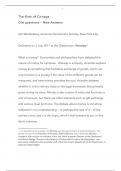1
The Birth of Coinage
Old questions – New Answers
Ute Wartenberg, American Numismatic Society, New York City.
Delivered on 3 July 2017 at the Ossolineum, Wrocław.1
What is money? Economists and philosophers have debated the
nature of money for centuries. Already in antiquity, Aristotle explains
money as something that facilitates exchange of goods, which can
only function in a society if the value of the different goods can be
measured, and here money provides the tool. Aristotle debates
whether it is the intrinsic value or the legal framework that primarily
gives money its value. Money is also a store of value and functions a
unit of account, but there are other elements such as gift exchange
and various ritual functions. The debate about money is somehow
reflected in our understanding – or perhaps the lack of it – of the
earliest coins, and it is this topic, which I shall present to you in this
short overview.
1
I am grateful for the invitation to Wrocław and the appointment as Visiting Professor. My
thanks are due to the President of Wrocław, Rafał Dutkiewicz, Kamil Eckhardt, Wrocław
Academic Hub and the co-ordinator of the visit, Adolf Juzwenko Director of the Ossolineum,
and Marcin Szeląg, Director of the Museum of Lubomirski Princes in the Ossolineum. I am
particularly indebted to the wonderful staff of the Numismatic Department of the Ossolineum, in
particular Adam Degler.
, 2
I shall introduce current research, some of which is about to be
published, in three areas that have considerably improved our
understanding of the early coinage2:
2
Due to the general nature of the presentation, some of the arguments and details are
abbreviated, and more details can be found in various articles in the bibliography and in
the forthcoming articles in White Gold: Studies in Early Electrum Coinage, ed. P. van
Alfen, U. Wartenberg, with K. Konuk, H. Gitler, W. Fischer-Bossert (American
Numismatic Society and Israel Numismatic Society, New York and Jerusalem).
, 3
1. our knowledge of the metal composition and method of
fabrication
2. current research about the dating of our primary archaeological
finds from the Artemision in Ephesos
3. why was electrum used for the earliest coinage?
The invention of agriculture, writing, the polis, and currency –
launching the means for food production on a larger scale, record
keeping, and thus the state and commerce respectively – were key
developments that changed the ancient Mediterranean world during
the Archaic period. A large body of scholarly inquiry exists for the
first three inventions, but surprisingly little sound research has been
done on coinage. Current investigations by a number of scientists
and scholars shed critical new light on the question of how the
earliest coins were minted, how their production was organized, and
how alloys were produced. By using a variety of new analytical
methods and techniques, some of these processes are beginning to
be better understood. An interdisciplinary approach, using evidence
from scientific analysis, geology, archaeological and historical data of
the Archaic Period in the eastern Mediterranean, allows us to re-
examine the key question why coinage was invented and provide
new data about the ancient economy.
, 4
Let us begin with the most basic question.
WHAT IS A COIN?
It is ordinarily defined as a piece of money, usually made of metal,
produced to a standard weight and particular size, with a design on
both sides, to which an authority, usually a government, has
assigned a specific value and thus authority.




